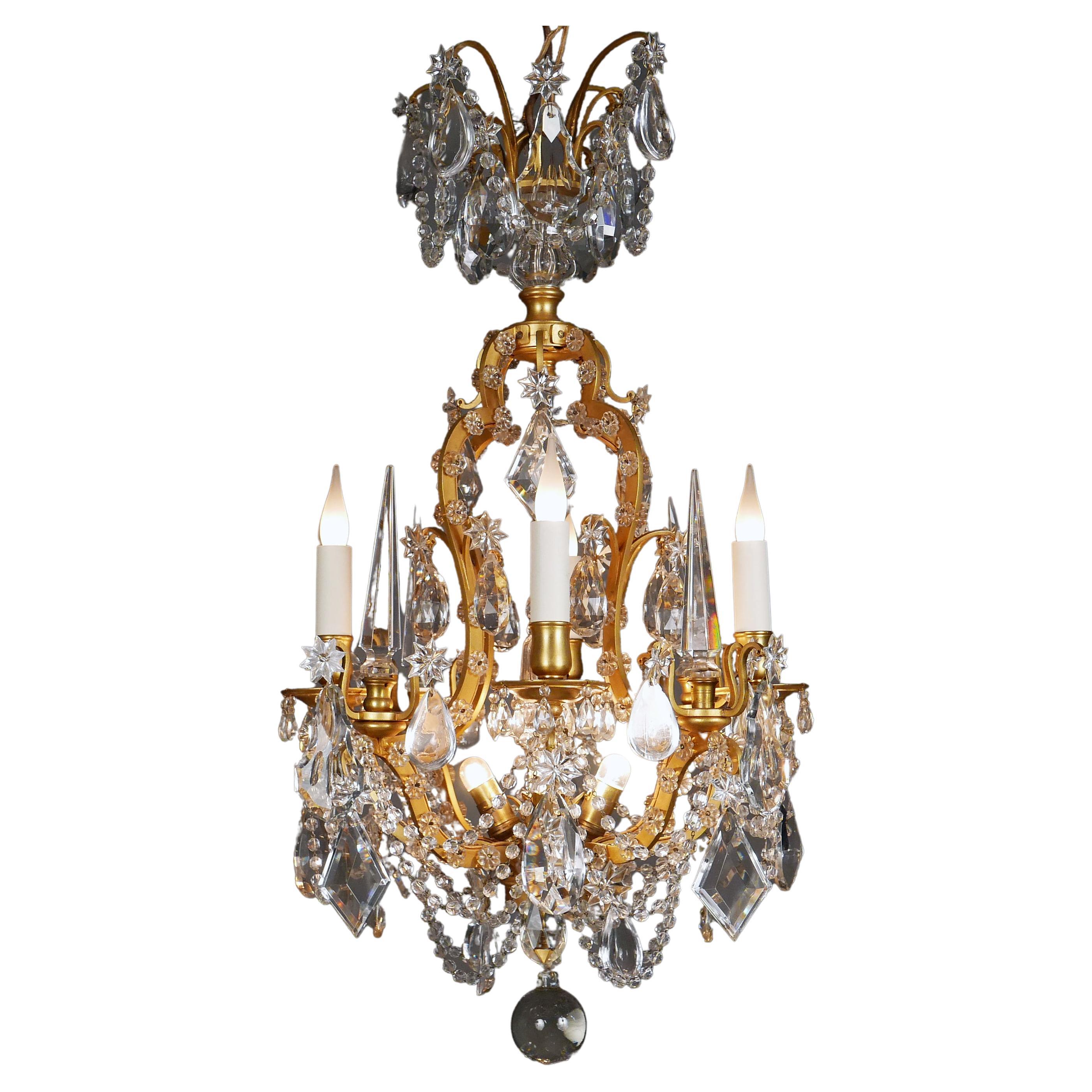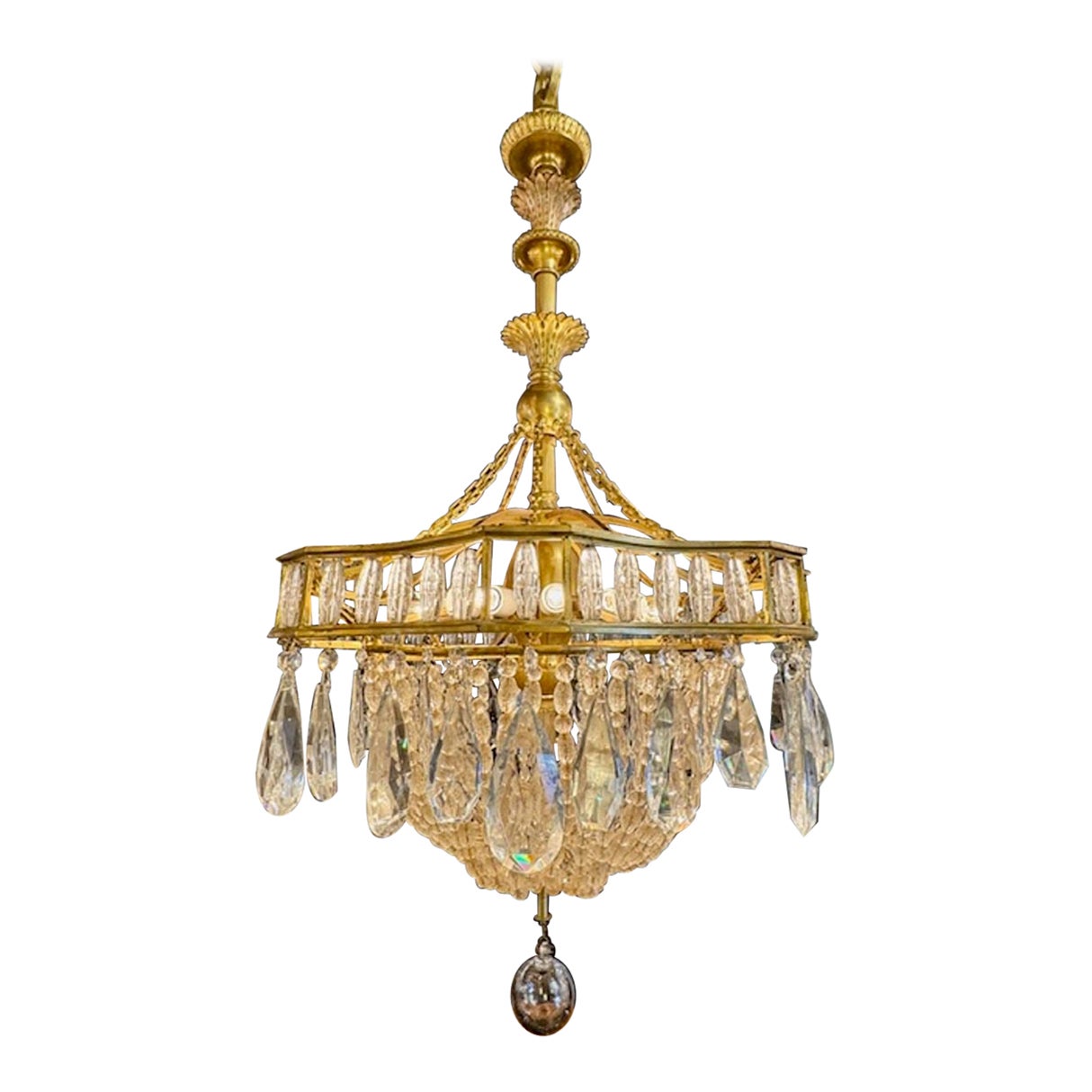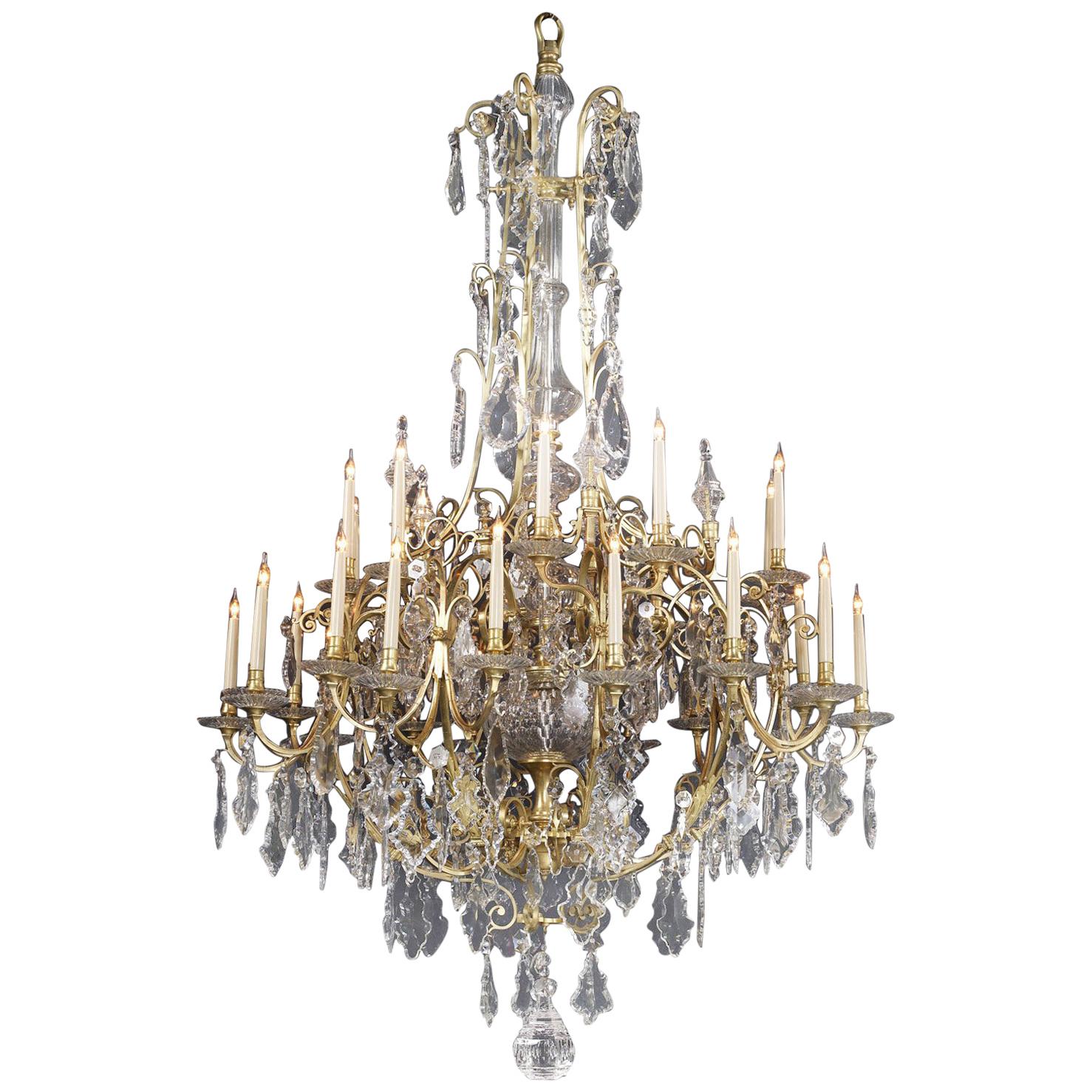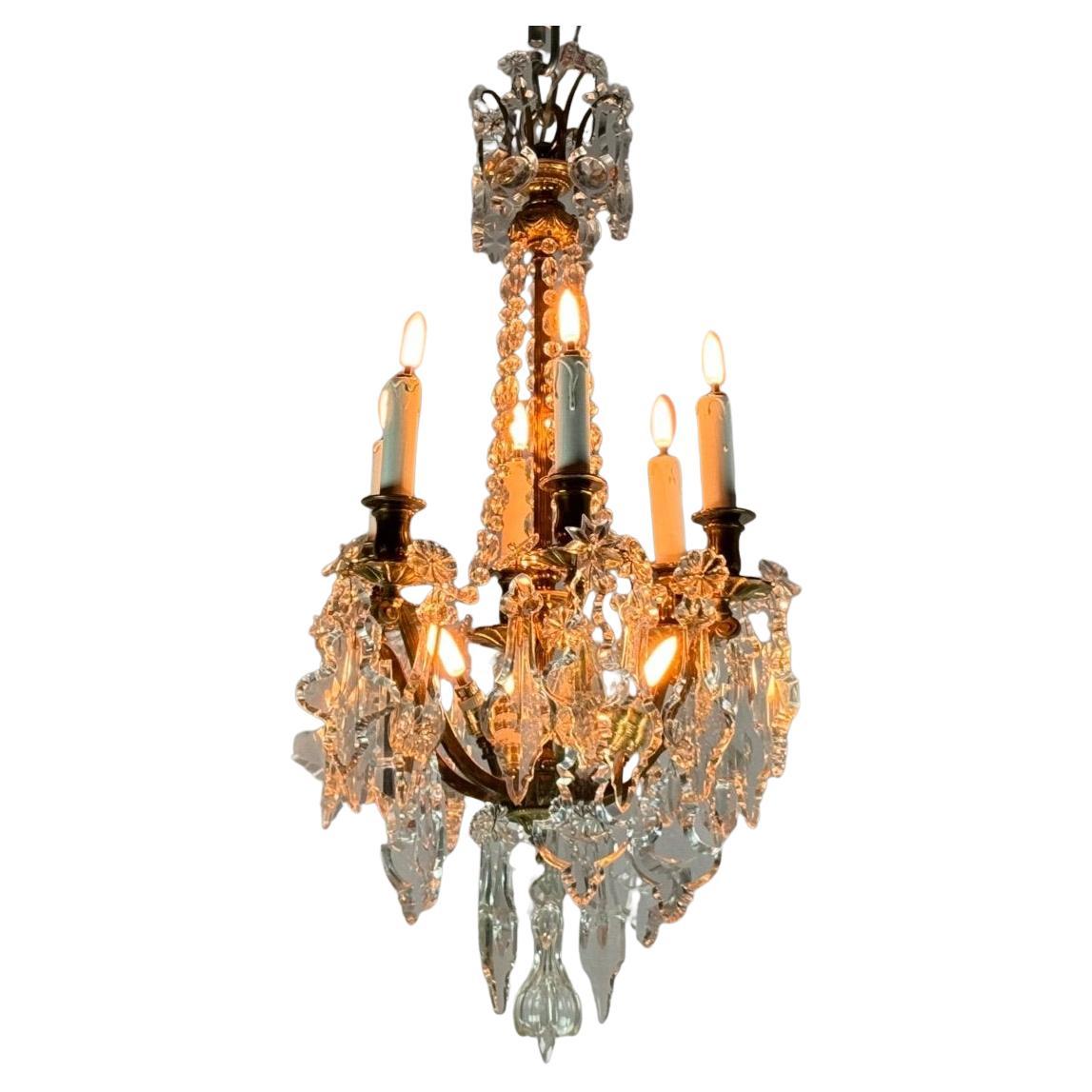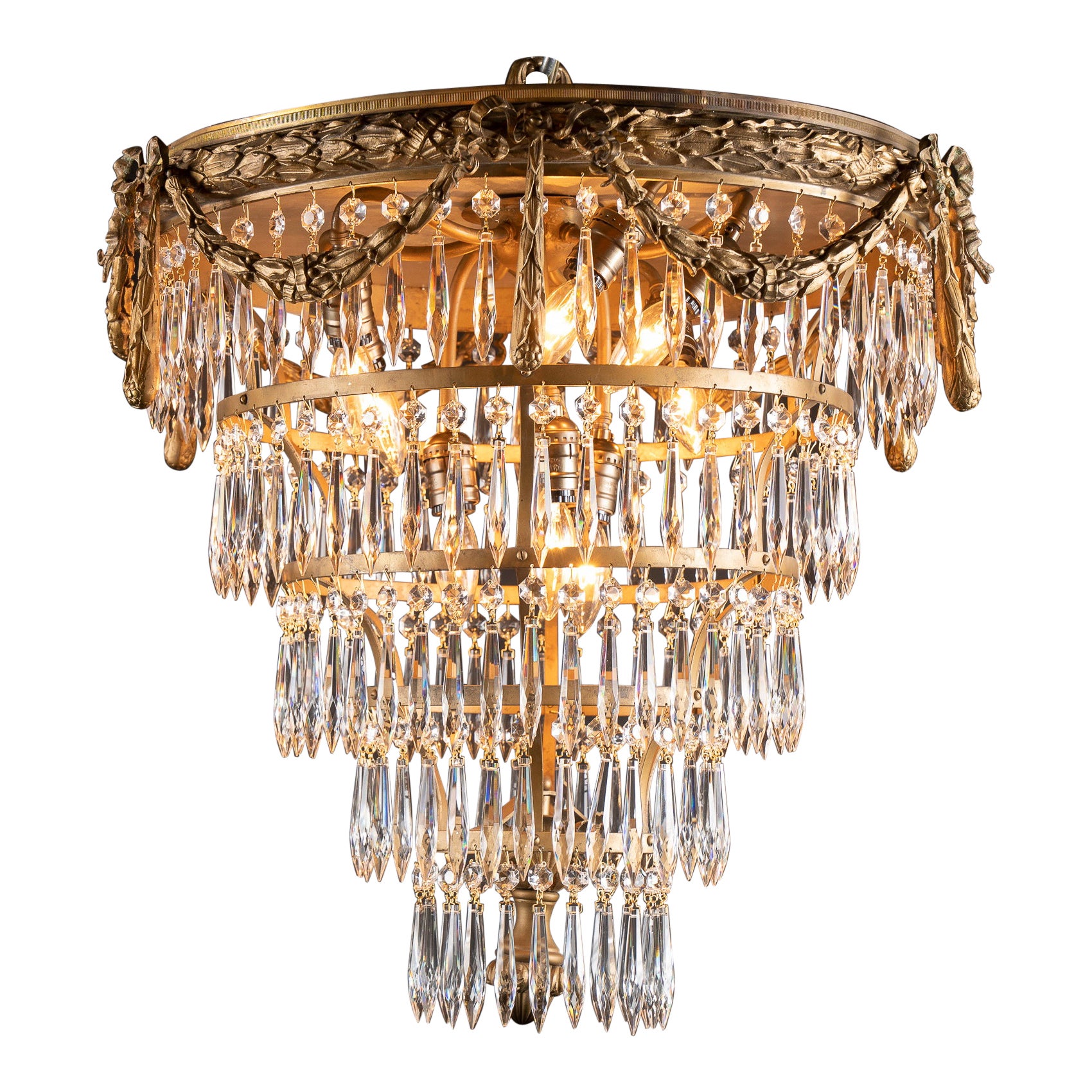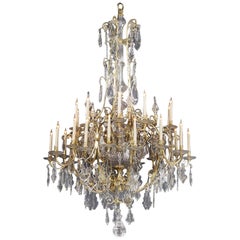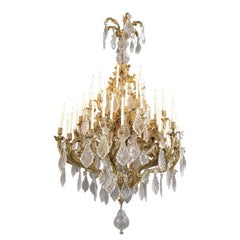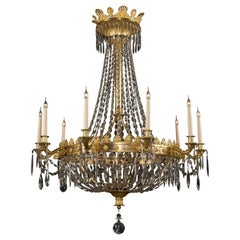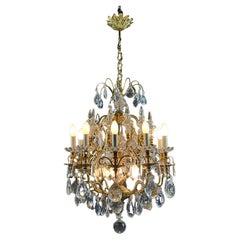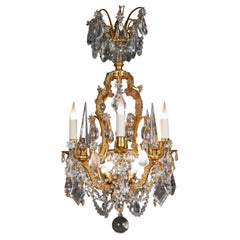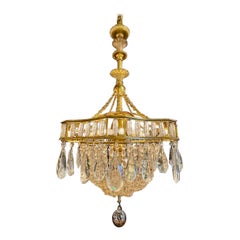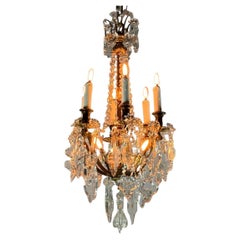Items Similar to Louis XVI Style Cage Chandelier Attributed to L'Escalier de Cristal, circa 1900
Want more images or videos?
Request additional images or videos from the seller
1 of 7
Louis XVI Style Cage Chandelier Attributed to L'Escalier de Cristal, circa 1900
$52,387.23
£38,000
€44,374.34
CA$72,434.67
A$79,524.23
CHF 41,487.96
MX$962,353.89
NOK 519,987.19
SEK 489,964.64
DKK 331,242.61
About the Item
A fine Louis XVI style gilt-bronze and glass cage chandelier with applied porcelain flowers, attributed to L'Escalier de Cristal.
French, circa 1900.
Fitted internally with eleven light fitments.
This fine chandelier is of cage form with a beaded trellis frame and chains of faceted drops. The gilt-bronze frame embellished all over with white porcelain flowers in the manner of Meissen.
L'Escalier de Cristal (1802-1923) was established by Marie Jeanne Rosalie Désarnaud-Charpentier, the daughter of a goldsmith from Châlons-sur-Marne, when she opened her renowned boutique in the Galerie de Valois of the Palais Royal in 1802. There she specialised in objects of great technical and aesthetic innovation, many composed entirely of crystal and gold plated bronze. What the previous century had done incorporating porcelain into objects and furnishings, Mme Désarnaud-Charpentier did with crystal in the nineteenth. Sadly very few of these crystal furnishings survive with us today.
Mme Désarnaud-Charpentier's fame was secured by the success of her innovative suite of furniture at the 1819 exhibition of the Produits de l'industrie, where she was awarded a gold medal. This toilette suite was purchased following the exhibition by one of Escalier de Cristal's most famous patrons, the Duchess de Berry, Louis XVIII's niece, and was subsequently installed in her country residence, the Château de Rosny-sur-Seine.
This exhibition, followed on from her success at the Paris 1801 exhibition. The competitive character of the exhibitions led many manufactories and maisons de luxe to create objects of increasing daring and originality; despite this for the judges and visitors the technical innovation of Escalier de Cristal's creations would have been a revelation.
In 1840, Pierre-Isidore Lahoche acquired L'Escalier de Cristal; joined later by his cousin Emile-Augustin Pannier, the company would become in 1867 Lahoche, Pannier et Cie. At the end of 1872, Pierre-Isidore Lahoche retired from business leaving his son-in-law in charge of the company. The boutique moved to the centre of Paris, at the corner of rues Auber and Scribe, a few steps away from Opera Garnier.
By 1885 the company was known simply as Pannier et cie, managed by Georges and Henri Pannier, sons of Emile. Henri Pannier was the art director whereas Georges took care of the finances. In the last decades of the 19th century the company widened its repertoire to include exceptional furniture in Louis XV and Louis XVI revival styles and ground breaking works by designer-ornamentists such as Edouard Lièvre. In the tradition of the 17th and 18th century marchand-merciers, they would collaborate with the finest bronziers, ebenistes, lacquers and painters of the day creating objects of unparalleled luxury and embracing sophisticated modernist styles such as extreme oriental and japonisant.
The company won multiple awards and medals at national and international exhibitions, including bronze medals at the Universal Exhibitions in London in 1862, and in Paris in 1867 and 1878. They were awarded a gold medal at the 1900 Paris Exposition Universelle.
The firm will finally closed in 1923.
The large number of objects that remain today in the possession of European Royal households, that were made by Escalier de Cristal, attests to the success and reputation the company achieved. Pieces also remain in the collections of the Louvre and Musée D'Orsay.
Bibliography:
De Commines, Laurent & Gizard, Eric. Un Âge D'or Des Arts Décoratifs 1814-1848, Réunion des Musées Nationaux, (Paris), 1991.
- Attributed to:L'Escalier de Cristal (Manufacturer)
- Dimensions:Height: 44.49 in (113 cm)Diameter: 19.69 in (50 cm)
- Style:Louis XVI (In the Style Of)
- Materials and Techniques:
- Place of Origin:
- Period:
- Date of Manufacture:circa 1900
- Condition:
- Seller Location:Brighton, GB
- Reference Number:Seller: B717501stDibs: LU1028015592892
About the Seller
5.0
Recognized Seller
These prestigious sellers are industry leaders and represent the highest echelon for item quality and design.
Established in 1964
1stDibs seller since 2014
58 sales on 1stDibs
Typical response time: 6 hours
Associations
The British Antique Dealers' AssociationLAPADA - The Association of Arts & Antiques Dealers
- ShippingRetrieving quote...Shipping from: Brighton, United Kingdom
- Return Policy
Authenticity Guarantee
In the unlikely event there’s an issue with an item’s authenticity, contact us within 1 year for a full refund. DetailsMoney-Back Guarantee
If your item is not as described, is damaged in transit, or does not arrive, contact us within 7 days for a full refund. Details24-Hour Cancellation
You have a 24-hour grace period in which to reconsider your purchase, with no questions asked.Vetted Professional Sellers
Our world-class sellers must adhere to strict standards for service and quality, maintaining the integrity of our listings.Price-Match Guarantee
If you find that a seller listed the same item for a lower price elsewhere, we’ll match it.Trusted Global Delivery
Our best-in-class carrier network provides specialized shipping options worldwide, including custom delivery.More From This Seller
View AllLarge Louis XV Style Cut-Glass Thirty-Light Cage Chandelier, circa 1870
Located in Brighton, West Sussex
A large and important Louis XV style gilt bronze and cut-crystal thirty-light cage chandelier.
French, circa 1870.
This fine chandelier is of a grand scale at 223 cm high (88 ...
Category
Antique Late 19th Century French Louis XV Chandeliers and Pendants
Materials
Bronze
Louis XVI Style Gilt-Bronze and Cut-Glass Basket Chandelier, circa 1900
By Pierre Gouthiere
Located in Brighton, West Sussex
A Louis XVI style gilt bronze and cut-glass basket chandelier with jasperware plaques, in the manner of Pierre Gouthière.
French, circa 1900.
The chandelier has five external ...
Category
Antique Late 19th Century French Louis XVI Chandeliers and Pendants
Materials
Bronze
Monumental Louis XV Style Cut-Glass Forty-Eight Light Chandelier, circa 1885
Located in Brighton, West Sussex
A monumental Louis XV Style gilt bronze and cut-glass forty-eight light chandelier.
French, circa 1885.
The frame is variously stamped with numbers and 'JL'.
This rare and...
Category
Antique Late 19th Century French Louis XV Chandeliers and Pendants
Materials
Bronze
Louis XVI Style Cut-Glass Ten-Light Tent and Bag Chandelier, circa 1900
Located in Brighton, West Sussex
A fine Louis XVI style gilt-bronze and cut-glass ten-light tent and bag chandelier.
French, circa 1900.
This impressive chandelier has a gilt-bronze crown cast with anthemions...
Category
Antique Late 19th Century French Louis XVI Chandeliers and Pendants
Materials
Bronze
Louis XV Style Twelve-Light Rock Crystal and Gilt-Bronze Chandelier, circa 1850
Located in Brighton, West Sussex
An Important Louis XV style twelve-light rock crystal and gilt-bronze chandelier.
French, circa 1850.
An important Louis XV style twelve-light rock crystal and gilt-bronze chandelier, surmounted by a floral corona, issuing six scrolling branches, each terminating with three circular drip pans and nozzles, decorated all over with drops, grapes, apples and baluster shaped shades.
The etymology of the word "crystal" has its origins in the Ancient Greek word for ice ‘krystallos’. Rock crystal which is always cool to the touch they considered to be ice permanently frozen by the Gods. For thousands of years Rock crystal has been prized for its beauty and remarkable ability to refract light. When cut and polished, the inherent striations and inclusions of the crystal create a refracted light richer in luminosity than that of manmade crystal or glass. These properties have made it highly desirable throughout history; its scarcity ensuring its use was limited to all but the most luxurious of decorative items.
Rock crystal is in reality a natural quartz, pure monocrystals of siliceous oxide. A material of exceptional hardness with indices of light refraction close to that of a diamond, quartz has been mined and worked since antiquity. In the Middle Ages, this rare material was used almost exclusively on religious objects. A prohibitively expensive material, Cristal de roche was first mined in France in small quantities in the 17th century and its rarity forced artisans to innovate.
The imitation of crystal began in Venice in the 15th century - the art of the glassmaker being to recreate the limpidity and luminosity of rock crystal. To do this, the glassmakers invented a 'crystal' made in reality of glass combined with a mixture of potassium, silicon, manganese and lead oxide heated to between 1200 and 1500 degrees. This crystal imitated rock crystal, although it displays a metallic colouring. This crystal de roche should not be confused with what is now called crystal. The latter was a development of 18th century Bohemia and, subsequently France with the Manufacture Royale de cristaux.
Rock crystal first appears as small beads on candelabras and chandeliers - not yet called lustres - in the 17th century. At the beginning of the 18th century the discovery of new seams in Central Europe allowed the mining of larger blocks of crystal, which could in turn be worked into pyramids, drops and stars. The highest value was historically based, like diamonds, on two things - the weight and the clarity or limpidity of the crystal. The clearer the better, hence the phrase d'une très belle eau when referring to crystal.
Perhaps the earliest recorded-reference in France is in 1697, when Louis XIV offered twelve grand 'lustres' in 'cristal de roche' to the King of Siam. Louis XV also possessed a chandelier with twelve branches in his chambre a coucher at Versailles which had been delivered by Delaroue and Slodtz. This was commented on by the duc de Luynes: 'on a mis dans la chambre du roi, un chandelier en cristal de roche d...
Category
Antique Mid-19th Century French Louis XV Chandeliers and Pendants
Materials
Bronze
Louis XVI Style Gilt-Bronze and Cut-Glass Eight-Light Chandelier
Located in Brighton, West Sussex
A fine Louis XVI style gilt-bronze and cut-glass eight-light chandelier,
French, Circa 1900.
Category
Antique 19th Century French Louis XVI Chandeliers and Pendants
Materials
Bronze
You May Also Like
Louis XV Style Cage Chandelier In Gilded Bronze And Baccarat Crystal
Located in BARSAC, FR
Magnificent cage-shaped chandelier in the Louis XV style with a gilded bronze frame and decorated with very rich Baccarat crystal ornamentation such as plaques, pendants, cups, dagge...
Category
Mid-20th Century French Louis XV Chandeliers and Pendants
Materials
Crystal, Bronze
"Cage" Crystal and Bronze Chandelier attr. to Maison Baguès, France, circa 1880
By Maison Baguès
Located in PARIS, FR
Charming Louis XVI style « cage » shaped chandelier in gilded bronze and cut crystal, with four lights. Many cut crystal pendants, daggers, prisms and flowers adorned the whole, connected with garlands of pearls. An indirect lighting...
Category
Antique 1880s French Louis XVI Chandeliers and Pendants
Materials
Crystal, Bronze
$5,731 Sale Price
30% Off
19th Century French Louis XVI Style Gilt Bronze and Crystal Basket Chandelier
Located in Dallas, TX
This 19th Century French Louis XVI Style chandelier is crafted from gilt bronze and adorned with crystal accents, showcasing a luxurious and elegant design. The basket style adds a t...
Category
Antique 19th Century French Louis XVI Chandeliers and Pendants
Materials
Crystal, Bronze
Gilt Bronze Cage Chandelier With Cut Crystal Pendants Circa 1900
Located in Honnelles, WHT
Gilt Bronze Cage Chandelier With Cut Crystal Pendants Circa 1900
Category
20th Century Italian Louis XV Chandeliers and Pendants
Materials
Metal
Tiered Louis XVI Bronze and Crystal Chandelier, French 19th Century
Located in New Orleans, LA
Beautiful French 19th century Louis XVI chandelier with bronze top ring and adorned with finely cast garlands and ribbons, dra...
Category
Antique 19th Century French Chandeliers and Pendants
Materials
Crystal, Bronze
Large Cage Chandelier With pendants, 18 Lights, Late 19th Early 20th Century
Located in MARSEILLE, FR
Elegant so-called "cage" chandelier in patinated bronze and ball-shaped crystal pendants, with inclusions in the ball to give the illusion of being made of rock crystal. Beautiful as...
Category
Antique Late 19th Century French Louis XV Chandeliers and Pendants
Materials
Bronze
More Ways To Browse
Cage Chandeliers
Louis Xviii
Caged Glass Chandelier
Large Late 19th Century French Bronze Chandelier
Escalier De Cristal
French Cage Chandelier
Chandelier With Porcelain Flowers
Porcelain Plates Of The Chateau
Eric Laurent
1940s Chandelier Brass
Glass Tulip
Lamp Pendant Swedish Modern
1930 Murano
French Ormolu Crystal
Pink Vintage Lighting Pendant
Blue Pendant Mid Century
Polished Cast Bronze
Alabaster Chandelier Modern

